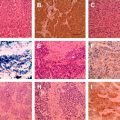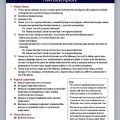Complete surgical resection is the main therapy for early-stage non-small cell lung cancer. Survival rates remain, at best, 80% for stage IA, necessitating the development of effective systemic therapy. Several large randomized control trials and meta-analyses provide evidence for the use of adjuvant chemotherapy for stage I to III, and are the basis for the standards of care. Cisplatin-based adjuvant chemotherapy regimens have shown 4% to 15% survival advantage at 5 years. Given this modest survival benefit, research is focused on the identification of prognostic and predictive markers to aid in the selection of appropriate adjuvant chemotherapy regimens.
Lung cancer is the leading cause of cancer mortality in the Western world with an estimated 222,520 new cases diagnosed in the United States in 2010. Lung cancer is broadly subdivided into two types, small cell and non-small cell, which account for approximately 15% and 85% of cases, respectively. Five-year overall survival of patients with non-small cell lung cancer (NSCLC) remains low at 17%. Even in the case of patients with sufficiently early cancer to be candidates for curative surgery, long-term survival is not guaranteed. When analyzed by stage, 5-year survival rates for stage I, stage II, and stage IIIA disease are 60%, 40%, and 25%, respectively. Recurrence or relapse of disease at distant sites is common and has prompted considerable research focused on chemotherapy for systematic therapy in an effort to improve long-term survival. As such, the use of adjuvant chemotherapy for early-stage NSCLC continues to evolve with the completion of numerous clinical trials and meta-analyses ( Table 1 ), the development of novel chemotherapeutic agents, and the identification of biomarkers associated with prognosis and response to chemotherapeutic agents.
| Trial | Number of Patients/Accrual Dates | Stage | Chemotherapy Regimen | Radiotherapy Included | Outcome with Adjuvant Chemotherapy |
|---|---|---|---|---|---|
| ECOG (2000) | 488 1991–1997 | II–IIIA | Cisplatin plus etoposide | Yes | Relative likelihood of survival 0.93, 95% CI 0.74–1.18; Median survival nonsignificant ( P = .56) |
| ALPI (2003) | 1209 1994–1999 | I–IIIA | Cisplatin, vindesine, mitomycin | Yes | Overall survival HR 0.96, 95% CI 0.81–1.13, P = .589 Progression-free survival HR 0.89, 95% CI 0.76–1.03, P = .128 |
| IALT (2004) | 1867 1995–2000 | I–III |
| Yes | Overall survival HR 0.86, 95% CI 0.76–0.98, P = .03 Disease-free survival HR 0.83, 95% CI 0.74–0.94, P <.003 |
| IALT Update (2010) | Median follow-up 7.5 years Overall survival HR 0.91, 95% CI 0.81–1.02, P = .10 Disease-free survival HR 1.33, 95% CI 0.89–2.0, P = .16 | ||||
| BLT (2004) | 381 1995–2001 | I–IIIB or IV |
| Yes | Overall survival HR 1.02, 95% CI 0.77–1.35, P = .90 Progression-free survival HR 0.97, 95% CI 0.74–1.26, P = .81 |
| JBR.10 (2005) | 482 1994–2001 | IB–II | Cisplatin plus vinorelbine | No | Overall survival HR 0.69, 95% CI 0.52–0.91, P = .04 Recurrence-free survival HR 0.60, 95% CI 0.45–0.79, P <.001 |
| JBR.10 Update (2010) | 9.3 year median follow-up Overall survival HR 0.78, 95% CI 0.61–0.99, P = .04 | ||||
| ANITA (2006) | 840 1994–2000 | IB–IIIA | Cisplatin plus vinorelbine | Yes | Adjusted risk for death with chemotherapy HR 0.80, 95%CI 0.66–0.96, P = .017 Overall survival at 5 years improved by 8.6% |
| CALGB 9633 (2008) | 344 1996–2003 | IB | Carboplatin plus paclitaxel | No | Overall survival HR 0.83, 90% CI 0.64–1.08, P = .125 Disease-free survival HR 0.80, 90% CI 0.62–1.02, P = .65 |
Clinical trials evaluating adjuvant chemotherapy
In 1995, the Non-Small Cell Lung Cancer Collaborative Group conducted a meta-analysis of 9387 patients from 52 randomized trials in an effort to address the controversial use of adjuvant chemotherapy for NSCLC. For patients with early disease, 14 trials were analyzed with varying chemotherapy regimens including: cyclophosphamide, nitrosourea plus methotrexate, cisplatin, doxorubicin, and cyclophosphamide, cisplatin and vindesine, and tegafur or tegafur plus uracil (UFT). The investigators identified differences in survival benefit according to the type of chemotherapy used. Results of the analysis favored the use of more modern regimens that included cisplatin because trials using long-term alkylating agents (cyclophosphamide and nitrosourea) were associated with an increased risk of death when compared with surgery alone. Although this analysis demonstrated a trend toward a survival benefit with the use of cisplatin-based drugs, the findings were inconclusive because the difference of 0.87 in the hazard ratio (HR) for overall survival was not significant ( P = .08). However, this result led to subsequent trials seeking to further assess the survival benefit of cisplatin-based postoperative chemotherapy.
Based on the trends reported in the 1995 meta-analysis, in 2004 the International Adjuvant Lung Cancer Trial (IALT) Collaborative Group performed a prospective clinical trial that was designed to evaluate the effect of cisplatin-based chemotherapy on survival after complete surgical resection. Patients were enrolled from 1995 to 2000, with a total of 1867 patients (stage I, II, or III; based on the 1986 American Joint Committee on Cancer classification) randomized to chemotherapy or observation in addition to surgery. Those patients randomized to the chemotherapy group received cisplatin combined with vindesine, vinblastine, vinorelbine, or etoposide; and 25% of these patients received postoperative radiotherapy (PORT). The investigators reported higher overall survival ( P <.03) and disease-free survival rates ( P <.003) for the group receiving chemotherapy in addition to surgery.
One year later, the North American Intergroup published the results of a randomized control trial (trial number JBR.10) that examined vinorelbine and cisplatin versus observation in stage IB and stage II NSCLC patients after complete resection. In this study, 482 patients were randomized to chemotherapy versus no adjuvant treatment. The chemotherapy group had lower rates of recurrence ( P = .003) and longer recurrence-free survival ( P <.001) when compared with the observation group. In addition, there was an absolute survival advantage at 5 years of 15% ( P = .03) for the surgery plus chemotherapy group. Subgroup analyses were also performed to assess survival differences based on histology, stage, and presence or absence of a ras mutation. Squamous cell cancer histology was found to be associated with greater recurrence-free survival ( P = .02). When patients were analyzed by stage, those with stage II disease in the surgery plus chemotherapy group were noted to have a longer medial survival than the surgery alone group (HR 0.59, P = .004), whereas chemotherapy did not provide a statistically significant increase in overall survival for patients with stage IB disease ( P = .79). However, the investigators cautioned against making conclusions based on this finding because the stage-by-treatment interaction test did not reach statistical significance ( P = .13) and the numbers required to demonstrate a response in early-stage cancer may not have been reached. Finally, the study found that patients with wild-type (normal) ras seemed to benefit from adjuvant chemotherapy; however, this finding was tempered by the fact that the effect of ras -mutation status on treatment outcome was not statistically significant.
Two years later, the Adjuvant Navelbine International Trialist Association (ANITA) reported their results on 840 patients randomized to either observation or treatment with vinorelbine and cisplatin after surgery, with some patients in each treatment group receiving postoperative radiotherapy. The results of this trial indicated a survival benefit for those patients treated with vinorelbine and cisplatin when compared with those patients in the observation group (HR 0.80, P = .017). The trial reported an 8.6% survival benefit at 5 years that was maintained at 8.4% at 7 years.
Following these trials, subsequent analyses building on the original 1995 meta-analysis were performed in an effort to update treatment recommendations. In 2007, Cancer Care Ontario and the American Society of Clinical Oncology published the “Adjuvant Chemotherapy and Adjuvant Radiation Therapy for Stages I-IIIA Resectable Non Small-Cell Lung Cancer Guideline.” In this treatment guideline, recommendations for the use of adjuvant chemotherapy were made based on eight meta-analyses and 16 randomized control trials. This guideline focused on patients who underwent an R0 resection and who were treated with a cisplatin-based chemotherapy regimen. Recommendations for treatment by stage were presented. Adjuvant cisplatin-based chemotherapy was recommended for stages IIA, IIB, and IIIA, but was not recommended for IA or IB. The use of alkylating agents as part of chemotherapy regimens was not recommended based on the conclusions of the 1995 meta-analysis. This was followed in 2008 by a pooled analysis conducted by the Lung Adjuvant Cisplatin Evaluation (LACE) Collaborative Group in which trials using adjuvant cisplatin-based chemotherapy regimens were evaluated in an effort to elucidate treatment options associated with improved survival. In addition, the analysis aimed to identify subgroups of patients who derived increased benefit from the administration of adjuvant chemotherapy. This analysis focused on trials that occurred after the 1995 meta-analysis and, ultimately, five trials, with data for 4584 patients (stages IA–III) were included. Furthermore, the analysis excluded trials in which neoadjuvant chemotherapy, non–cisplatin-based regimens, or concurrent radiotherapy and chemotherapy was administered. The investigators concluded that adjuvant chemotherapy improved survival and that this effect varied with stage.
However, not all the trials conducted demonstrated a significant improvement in overall survival associated with the use of adjuvant chemotherapy. The Eastern Cooperative Oncology Group found neither significant decrease in intrathoracic recurrence ( P = .58) nor improvement in survival ( P = .56) with adjuvant chemotherapy plus radiotherapy versus radiotherapy alone. The trial included 488 stage II and IIIA patients with a median follow-up of 44 months and a chemotherapy regimen consisting of four cycles of cisplatin and etoposide. Of the 232 patients randomized to the chemotherapy and radiotherapy treatment arm, 69% completed all or part of the full four cycles. The investigators noted that the combination of chemotherapy and radiotherapy was associated with significant side effects that were not associated with radiotherapy alone.
In 2003 the Adjuvant Lung Project Italy/European Organization for Research and Treatment of Cancer-Lung Cancer Cooperative Group Investigators reported results of a randomized trial studying survival of stage I to IIIA NSCLC patients treated with chemotherapy versus observation. Patients treated with radiotherapy were included in both the chemotherapy group (mitomycin, vindesine, and cisplatin) and the control group. Randomization was performed on 1209 patients, with a median follow-up time of 64.5 months. The investigators found no statistically significant improvement in overall survival between the adjuvant chemotherapy group and the no-treatment group ( P = .128). Similarly, in this trial, 69% of patients in the chemotherapy group completed the planned three cycles of treatment. The following year, results of the Big Lung Trial were published and, again, no significant benefit from adjuvant chemotherapy was demonstrated ( P = .90). The 381 stage I to III patients were randomized to the treatment arms of the study at the individual treating doctor’s discretion. The trial included patients who had received neoadjuvant chemotherapy or adjuvant chemotherapy, plus or minus radiotherapy, versus surgery alone. Most patients in the treatment group of the trial received adjuvant chemotherapy (97%) versus neoadjuvant chemotherapy (3%). Four options for chemotherapy regimens were used: (1) cisplatin, mitomycin, and ifosfamide; (2) cisplatin, mitomycin, and vinblastine; (3) cisplatin and vindesine; and (4) cisplatin and vinorelbine.
More recently, the Cancer and Leukemia Group B, Radiation Therapy Oncology Group, and North Central Cancer Treatment Group Study Groups (trial number CALGB 9633) reported a negative trial of adjuvant paclitaxel plus carboplatin versus observation in patients with stage IB NSCLC. Three hundred and forty-four patients were randomized to adjuvant chemotherapy or observation and no radiotherapy was administered in either treatment group. There was no significant survival advantage for the patients in the chemotherapy arm after a median follow-up of 74 months ( P = .12). However, the investigators did note a significant survival benefit for patients in the chemotherapy group with tumors greater than or equal to 4 cm ( P = .43).
In 2010, updates of both JBR.10 and the original 1995 meta-analysis were published. The JBR.10 update provided results after a median follow-up period of 9.3 years, compared with a median follow-up of 5.1 years in the chemotherapy group and 5.3 years in the observation group in the original report. The absolute survival benefit for the chemotherapy group continued to be observed, at 11% compared with the 15% published previously. Survival benefit was statistically significant for patients with stage II disease ( P = .01); however, it failed to reach significance for stage IB patients ( P = .87). In agreement with the CALGB 9633 trial, tumor size of greater than or equal to 4 cm was found to be predictive of chemotherapy effect ( P = .02). The investigators found no significant interaction between ras mutation status and overall or disease-specific survival. In the 1995 meta-analysis update, the investigators analyzed updated data from previously included trials in addition to including trials that began randomization after January 1, 1965. Selection of trials for analysis was also refined to perform two meta-analyses: (1) surgery plus adjuvant chemotherapy versus surgery alone or (2) chemotherapy, surgery, and radiotherapy versus surgery plus radiotherapy. In the first meta-analysis, the investigators found a significant survival benefit for surgery plus chemotherapy compared with surgery alone ( P <.0001). The second meta-analysis demonstrated a survival benefit for surgery, chemotherapy, and radiotherapy ( P = .009).
Stay updated, free articles. Join our Telegram channel

Full access? Get Clinical Tree






